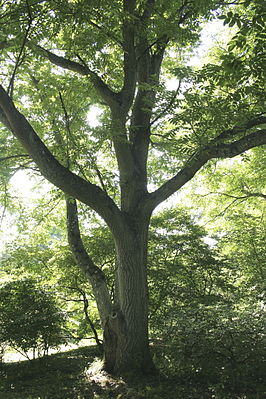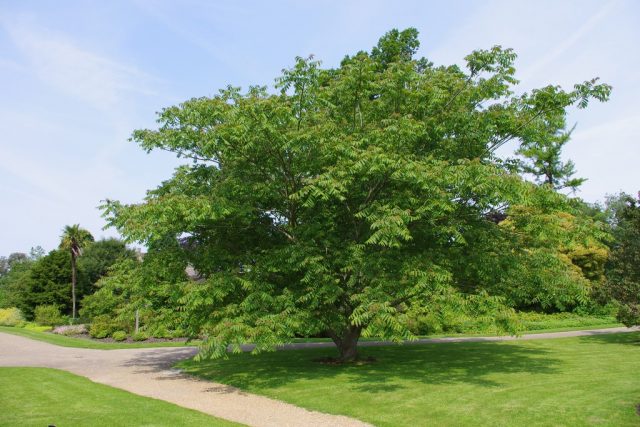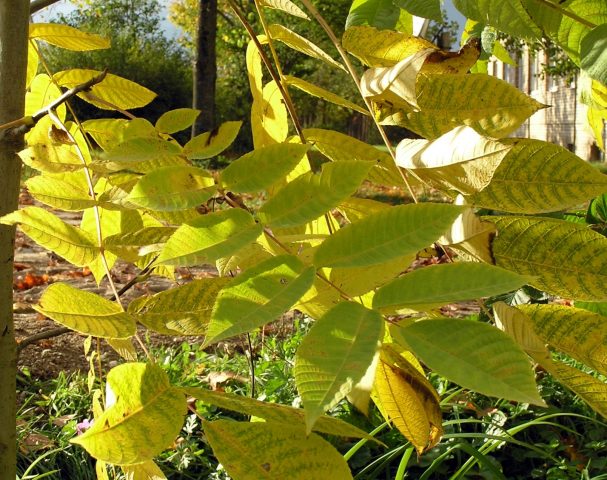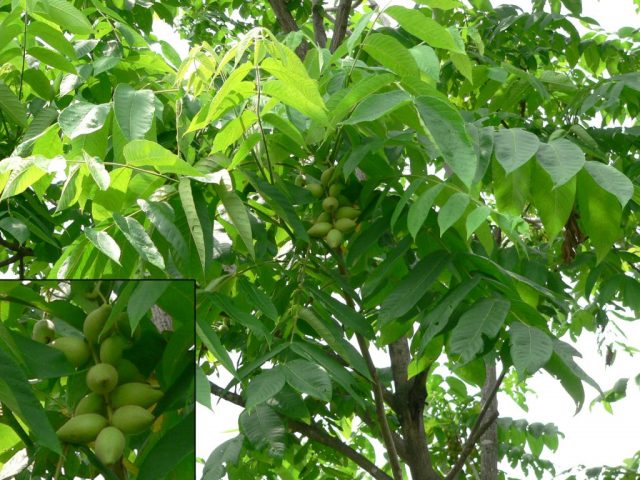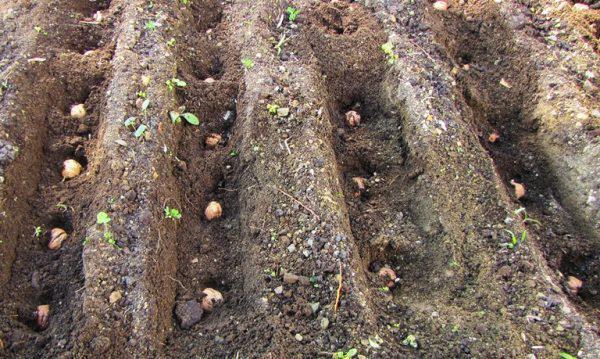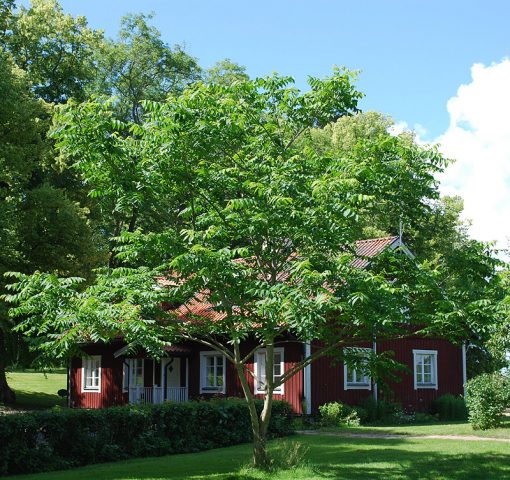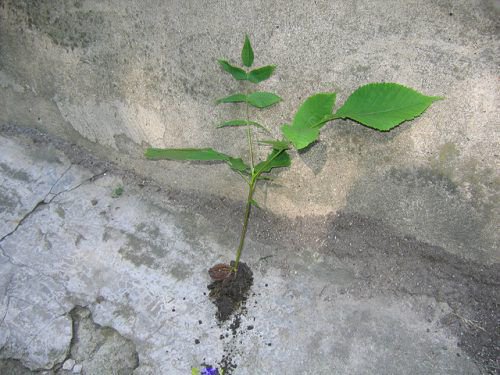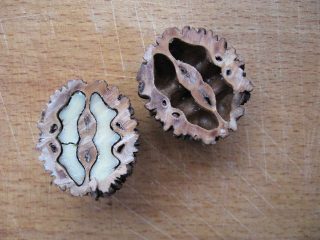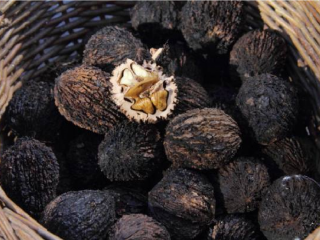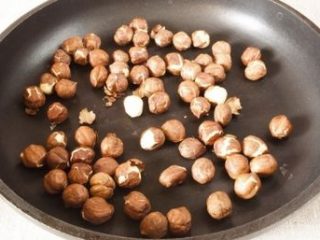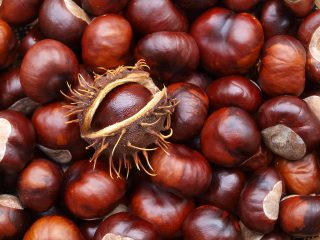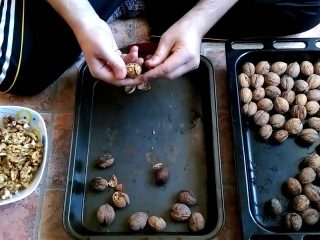Content
- 1 Manchurian walnut description
- 2 How to germinate a Manchu nut at home
- 3 How to plant a Manchu nut
- 4 How to grow a Manchu nut
- 5 Features of cultivation in different regions
- 6 When to harvest Manchu walnut
- 7 Why the Manchu nut does not bear fruit
- 8 How to propagate a Manchurian nut
- 9 Pests and diseases of the Manchurian nut
- 10 Conclusion
Many gardeners in the northern regions dream of growing walnuts. But, even if it is possible to grow a tree to a more or less adult state, then it is almost impossible to get ripe fruits from it. A good alternative to it is the Manchu nut, which feels good in the north of the middle zone, up to the Arkhangelsk region, and in the Urals and Siberia. Below are a variety of photos and descriptions of the Manchu walnut along with details on the requirements for the culture and how to care for it.
Manchurian walnut description
This tree has several more names - Dumbey nut, Ussuri hazel. For the inhabitants of the seaside region, this giant is not at all any wonder. Since his homeland is the Far East, China and the Korean Peninsula. In the wild, it grows in river valleys, on humus-rich, breathable soils, in deciduous forests and in mountainous areas up to an altitude of 500-600 m.
Hence its basic requirements for growth conditions. Trees show a high demand for soil fertility. On too heavy, clayey and cold soils, it develops slowly, dry tops appear prematurely, the tree may even die. It can withstand a temporary lack of moisture, since it has a deep root system. And flooding endures only in a short-term mode.
Of all walnut trees known in nature, this particular variety is the most frost-resistant. It can endure winter frosts down to - 46 ° С, and according to some reports even up to - 52 ° С.
True, more trees of this species suffer not so much from winter frosts as from late spring frosts. Its youngest shoots and leaves do not tolerate even a short-term drop in temperature to - 3-4 ° C, they can turn black and crumble. Together with them, flowers also suffer, as a result of which fruiting in the current season may be either too weak, or it may not be expected at all. Of course, the growth of new young shoots resumes from the spare buds, but the general development of the tree is delayed, and the shoots may not have time to ripen until next winter.
This nut is light-loving, but can tolerate partial shade. And in the first few years of life, it even needs some shading. But if you provide it with a lot of light, this will lead to an expansion of its crown, an acceleration of the onset of fruiting, and an increase in yield.
The trees are relatively smoke and gas resistant. Therefore, they are perfect for landscaping large cities.But even in the country, if you provide him with enough free space, the Manchu nut will feel great, creating shade and comfort and protecting from blood-sucking insects.
In natural conditions, trees can reach 28-29 m in height. The trunk width is on average 60-70 cm, but sometimes it reaches 100 cm in diameter.
The trunk is usually straight and even, covered with deeply grooved dark gray bark. Young shoots are yellowish-brown, pubescent. The wood has a very nice, firm texture. It can be used to make furniture and a variety of art items.
Manchurian nut crown
Walnut trees have a decorative crown, which can be spreading or wide-rounded, openwork or rather dense. This is one of the most picturesque trees in the Far Eastern taiga, which even resembles some varieties of palm trees in its appearance. Under natural conditions, it often has several trunks. In culture, it can be made a single-stemmed plant. The crown diameter can be up to 10 m.
However, in the northern regions, it even grows in the form of a shrub, which does not at all interfere with harvesting nuts from it.
Manchurian walnut leaves
Of course, such a decorative appearance of the crown is determined, first of all, by the shape and size of the leaves. They are larger than walnut leaves. In length they can reach 100-125 cm, and in width - up to 40 cm. The leaves are pinnate. Each leaf consists of 15-19 leaves.
Manchurian walnut leaves have a rich set of essential oils, phytoncides, alkaloids and other beneficial substances. Therefore, when rubbed, a strong characteristic odor appears. Phytoncides, which secrete leaves, drive away mosquitoes and other insects, so pests practically do not bother the plant. And it itself serves as a reliable protector from blood-sucking insects when decorating a recreation area on a personal plot.
In addition, the leaves change their color during the growing season, which makes the trees even more attractive. In spring, the leaves are grayish-green, due to pubescence, in summer they turn bright green, and in autumn they acquire a yellow-golden hue.
Manchurian nut roots
The root system of trees as huge as the Manchurian walnut is very powerful and deep. Due to this, the trees are resistant to strong hurricane winds and can even survive a short-term drought. They develop a deep taproot and shallow lateral roots can also be helped to form. To do this, after the first year of life, the root is cut at about a depth of 40 cm.
How the Manchurian walnut blooms
Being a monoecious plant, the Manchurian nut forms separately female and male flowers. Male flowers look very picturesque, hanging in the form of long earrings, which are formed simultaneously with the blossoming buds. Female flowers are presented in the form of small few-flowered brushes that form at the very tips of the shoots.
Pollination occurs mainly due to the wind. The flowering time begins around April-May. Dates of blooming of male and female flowers do not always coincide on the same tree, which can complicate self-pollination. Therefore, in order to guarantee harvests, it is recommended to plant several trees of this variety.
Manchurian nut fruit
The fruits of the Manchurian walnut slightly resemble walnuts, but differ in size, shape and, most importantly, in internal content, which is clearly visible in the photo of the tree:
On the branches, they are fixed in the form of bunches of 3-8 pieces. They ripen during the period of yellowing of the foliage, which, depending on the weather conditions of the region, can happen at the end of August and throughout September.
The fruits are oval and even slightly oblong in shape. They are covered with a pericarp, which is initially a thick green rind. As the nuts ripen, the pericarp begins to turn brown and then become covered with dark spots. This means that the fruits are ripe inside. The ripening process is usually uneven and can last for a month. Ripe nuts fall down from the tree and the pericarp is fully revealed.
The fruits themselves have a very strong and tough shell, compared to walnuts. Fruit sizes are about 3 cm wide and up to 6 cm long.
The nut kernels inside are not only edible, but also have a delicious taste. They contain about 55% of the valuable edible oil. True, the mass of the nucleoli in relation to the mass of the whole fruit is only about 20%. In addition, they are quite difficult to extract from nuts.
But the good quality of the fruit reaches 98%. This means that the percentage of quality (unspoiled) kernels in nuts is very high.
Nutshells are a valuable material for making decorative ornaments, boxes and other folk art items. It is also used as a dye to create various dark color shades.
How fast the Manchu nut grows
This nut is capable of both developing and growing very quickly. Annual seedlings have a height of about 25-30 cm. Already in the second year, depending on the growth conditions, they can reach a height of 50-80 cm. In three years, the height of some seedlings can exceed 100 cm. And at 5 years old, they can reach 2 m. In the period from 5 to 20 years, the growth rate may be the highest. So, the annual growth during this period can be from 50 cm to 1 m.
Under natural conditions, 10-year-old trees can reach a height of 4-5 m, and their trunk diameter is 5-6 cm. The most intensive growth of a tree continues up to 80-90 years, and then significantly slows down. Moreover, trees can easily live up to 200, and sometimes up to 300 years. But after they turn 100 years old, the main growth stops, and new shoots grow only to replace the damaged ones.
What year does the Manchu nut bear fruit?
The timing of the entry into fruiting depends on the growing conditions and on the care carried out for the tree. Under good conditions, the first fruits can appear at 5-7 years of age. But decent harvests from a tree can be expected only for 12-14 years of life.
How to germinate a Manchu nut at home
The seed propagation method is the main one for this nut. Since the cuttings root very poorly and require the use of stimulants and a special professional approach. Some valuable varieties can be propagated by grafting to maintain the purity of the variety. Indeed, with seed reproduction, it is not always possible to guarantee the complete preservation of the qualities of the mother plant.
Seed germination with soil sowing is about 70%. And if you germinate nuts at home, then their germination can be increased to 85-90%. But for this it is necessary to carry out preliminary stratification, and the planting of the Manchurian walnut will be carried out in the spring. For successful germination, it is best to take one- or two-year fruits. Starting from the age of three, the germination rate of nuts begins to decline rapidly.
The following are step-by-step steps for sprouting nuts at home.
- Immediately after collection, the nuts are stored in a cellar or in another cool place until the beginning of stratification.
- Stratification can take from 2 to 6 months. Therefore, already in November or December, the fruits are removed from the storage area and placed in a container filled with wet river sand.
- The nuts should be completely covered with sand.
- The container is placed in a plastic bag with several holes and placed in a place with a temperature of about + 3-5 ° C for two months.Important! Once a week, the container with fruits should be checked for moisture retention and mold.
- After a few months, some nuts can begin to sprout on their own.
- In any case, about a month before the intended planting in the ground, the fruits are removed from the sand and washed in warm water.
- Then the nuts are placed in a deep container filled with warm water for about 10 days. The water in the container must be changed every day.
- At the last stage, the fruits are placed in a box with sterile light soil at a depth of about 7-8 cm.
- The box is left at room temperature.
- Within a month, the nuts should germinate to some extent. For some, the shell may simply break apart, while for others, a root and sprout may even form.
The fruits are now ready for planting in the ground. If it's still cold outside, you can temporarily plant them one at a time in large pots. But it should be borne in mind that the development of seedlings can occur too quickly, and the root can be easily damaged during transplantation.
There is another way of the so-called accelerated stratification of nuts. To do this, in March, the fruits are poured with hot water (with a temperature of about + 50-70 ° C) for a day. Then the fruits are buried in wet sand and left in normal room conditions. After a month, the nuts begin to sprout and they can be transplanted into open ground, preferably to a permanent place.
How to plant a Manchu nut
A planting site for good growth and development of trees should be chosen taking into account the following factors:
- At the planting site itself and nearby within a radius of 10 m, there should be no capital buildings and tall trees in order to avoid problems with the root system in the future.
- It is known that the excretion of the leaves of the Manchurian nut has a depressing effect on the growth and development of some plants, in particular, grapes and irgi. Therefore, planting walnut should not be placed near these plants.
- The place should not be flooded in the spring, and the water table should not be too high.
- The reaction of the soil for planting seeds can be any: from slightly acidic to slightly alkaline. It is only desirable to provide good drainage and some supply of nutrients. Usually, the addition of wood ash is used for these purposes.
- To ensure good drainage, the bottom of the planting hole is laid with a mixture of stones or broken brick and sand to about 1/3 of the depth of the hole dug.
If there are any ambiguities in the description of planting a Manchu nut, then the photo or the attached video will help illustrate the subtleties of the process.
The depth of planting seeds is 8-10 cm. Usually 2-3 nuts are laid in one hole, and then only the strongest sprout is left. In this case, the distance between the holes is about 10-12 m.
You can act differently. Sow seeds in a so-called school, from where they will be transplanted to a permanent place of growth in the fall. In a school on one square. m, you can place no more than 10 fruits.
You should know that seedlings of Manchurian walnut in the first year of life, first of all, grow a taproot, the length of which can reach 50-70 cm by autumn. And the aboveground part develops at a much slower pace. For this reason, it is advisable to transplant as soon as possible. Already in the second year of life, there is a possibility of causing significant damage to the root system when transplanting a seedling to a permanent place.
If you process the fruits before planting with kerosene or another means of protection that is unattractive to mice, then the best option would be to plant them in the ground in the fall, almost immediately after collection. In this case, there is no need for stratification, since it occurs naturally.Nuts germinate much faster than in spring planting, seedlings are more powerful and viable, and by autumn the wood on the shoots has time to mature well and thereby prepare for the harsh winter conditions.
Fruits are usually planted shortly before the establishment of permanent snow cover. And they make sure that in winter the landing site is constantly covered with a large layer of snow.
How to grow a Manchu nut
Growing this type of nut is not as difficult as it might seem, especially if you follow all its basic care requirements.
How to water and feed
The Manchu nut is quite picky about the amount of moisture present in the roots. He does not tolerate long-term stagnation of moisture (more than 5-7 days), and its lack. Young seedlings, which still have an insufficiently developed root system, are especially sensitive to a lack of moisture. In the first two years of life, young plants require regular watering, at least once a week, especially if the weather is dry. From the third year of life, it is enough to water the trees once a month. In severe drought, young seedlings can be additionally irrigated with a hose or sprayer to keep the leaves and young shoots fresh.
Top dressing is necessary for young trees, starting from the second year of life. It is best applied in May-June, during the period of the most intensive growth and formation of trees. Potassium-phosphorus fertilizers are used as top dressing. Most often it is wood ash with superphosphate. If necessary, feeding can be repeated at the end of July, beginning of August, but not later, so as not to cause excessive growth processes during this period.
A useful procedure for the cultivation of all types of nuts is the annual digging of trees in a strip running approximately around the circumference of the crown. This is usually done in the spring after the ground has completely thawed. This procedure contributes to oxygenation of the upper layers of the earth. You can lightly cover the dug trench with humus, which will serve as an additional top dressing for the tree.
How to prune a Manchu nut
If the Manchu walnut has enough free space for normal growth, then it practically does not need pruning and crown formation. It naturally has an attractive wide crown without any special tweaks. Therefore, pruning must be carried out exclusively for sanitary purposes, while removing dried or broken branches.
Moreover, this procedure is carried out mainly in late spring, so as not to cause too much trouble for the trees at the time of the greatest sap flow.
How to shape a Manchu nut
The formation of a tree, as mentioned above, is not required if the plant is provided with optimal conditions for growth and development. If, for some reason, the gardener wants to form a bush from a tree or reduce the total height of the plant, then it is necessary to cut the central trunk in half in the second year. In this case, the tree will grow as a multi-stemmed composition.
How to prepare a Manchu nut for winter
It is advisable to additionally insulate young seedlings before winter. For this, the stem and the main skeletal branches are wrapped with non-woven insulating material or just burlap. To protect the Manchurian walnut tree from damage by rodents, it is additionally wrapped in a net, which is also buried in the ground around it. After heavy snowfalls, the snow surface around the tree trunks is additionally trampled to prevent rodents from breaking through the passages in the root zone of the trees.
This type of nut is particularly susceptible to sunburn, which is especially dangerous in the spring.Therefore, in autumn and spring, the trunk and the main skeletal branches must be coated with a mixture of lime and clay solutions with the addition of an adhesive.
Features of cultivation in different regions
Due to its special frost resistance and relative unpretentiousness, the Manchurian nut can be grown in various regions of Russia, where it can easily replace the more thermophilic and unstable varieties of nuts.
Growing Manchu nuts in Siberia
Oddly enough, the harsh Siberian conditions are quite suitable for the successful cultivation of this variety of walnut. Trees endure especially low winter temperatures relatively easily. Both spring and summer in Siberia come later than in the middle zone. But on the other hand, the trees wake up later and do not have time to get under the spring frosts, which can greatly delay the development of nuts in the middle lane.
Of course, sowing seeds in Siberian conditions shifts to May and roughly coincides with the period when potatoes are usually planted. And in the fall, it is advisable to wrap young seedlings harder, especially in the first years of life. Otherwise, planting and caring for Manchu nuts in Siberia is no different from other regions.
Growing Manchu nuts in the Urals
When growing Manchurian nuts in the Urals, all standard requirements for caring for this crop should be observed.
Of the features, one can only notice that it is advisable to plant and transplant seedlings in the spring, so that the trees have more opportunities to settle down in a new place and get stronger.
The second feature of care concerns the pruning procedure. In the Urals, both early (in April, May and even in the first half of June) and late (July-August) pruning can cause damage to trunks and branches, which will be more susceptible to freezing in these places in winter. Therefore, tree pruning can be carried out in the Urals only in the second half of June or early July.
Growing Manchurian nuts in the Moscow region
In the Moscow region, special attention must be paid to feeding and the health of the tree, since its vitality and ability to overcome unfavorable weather conditions (late spring frosts) most of all depend on this. Both planting and caring for Manchurian nuts in the Moscow region should be carried out very carefully, in compliance with all agrotechnical methods (watering, feeding, mulching, digging-loosening).
For top dressing, you can use complex fertilizers in early summer and phosphorus-potassium fertilizers in the second half of summer.
Warming young seedlings for the winter and protecting them from sunburn in spring is also more than relevant.
When to harvest Manchu walnut
Depending on the climatic conditions of the region and the characteristics of this particular nut variety, its fruits ripen from late August to late September. Usually ripe fruits fall off the tree by themselves, so picking them is not particularly difficult. The fruiting period can be extended to 3-5 weeks. If there is a desire to make jam from green fruits (similar to what is made from walnuts), then they are harvested green directly from the tree at the end of June or in July.
Why the Manchu nut does not bear fruit
The most common reason for the lack of fruiting in the Manchu nut is the freezing of female and male flowers during late spring frosts. Indeed, for them, a one-time decrease in temperature to - 1-2 ° C is enough, so that in the current season the ovaries could no longer form. And if this situation is repeated annually, which in recent years may be quite a frequent occurrence, then the fruit may not be formed for several years in a row.
Planting seedlings in conditions of significant shade can also cause significant delays in the onset of fruiting.
Sometimes the exactingness of nuts to soil fertility can affect.Although sometimes they can "heal" in too comfortable conditions, and the fruit in this case, too, can not wait.
And the simplest reason for the lack of fruit is the cultivation of a single tree, in which female and male flowers bloom at different times. To prevent this from happening, it is necessary to take care in advance that the trees do not grow in splendid isolation, but have several brothers growing nearby.
How to propagate a Manchurian nut
The Manchurian nut gives active growth from a felled stump and is able to maintain this ability until a ripe old age. Therefore, the tree can be rejuvenated at any time.
But the most common breeding method for this nut is by seed, which is described in detail above.
Experts also practice the method of propagation of especially valuable varieties by means of grafting.
Manchurian nut grafting
The main problem with this method of propagation is that an adult tree will not work as a rootstock. It is necessary to grow a stock from seeds so that its trunk is approximately equal in diameter to the branch that is going to be grafted.
Especially popular is the Manchurian walnut grafting. This makes it possible to grow a walnut tree that is more resistant to low winter temperatures.
Pests and diseases of the Manchurian nut
With proper care, this type of nut is practically unaffected by pests and diseases. Mainly due to the actively released phytoncides of the leaves, which scare off parasites.
Among the potential pests, only walnut and gall mites can be noted, which are fought with the help of special insecticides. And of the diseases, only black spot is found, which is easy to get rid of with the help of copper-containing preparations.
Conclusion
A photo and description of the Manchu nut, which can be found in the article, will help, even in difficult climatic conditions, to grow trees that yield fruits that are not inferior in taste and nutritional value to southern walnuts.
